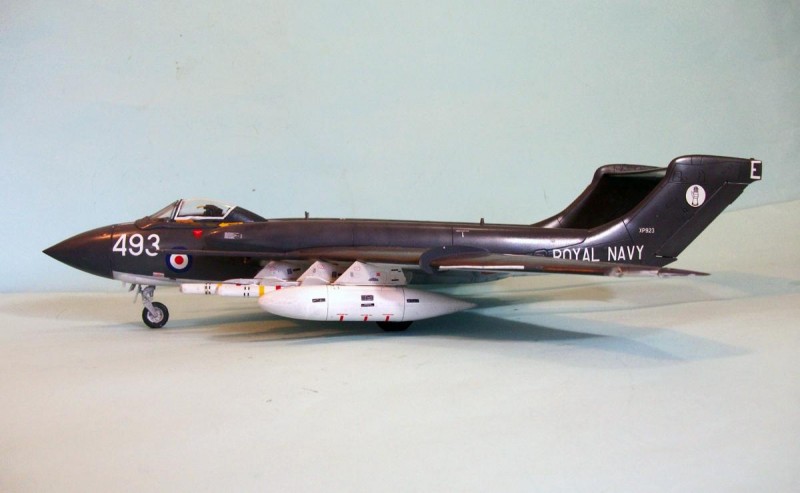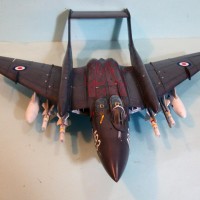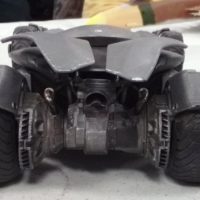Airfix 1/48 Sea Vixen
A nice counterpoint to the Javelin.
In 1947, the Royal Navy promulgated a specification for a fleet defense fighter at the same time that the RAF issued a similar requirement. De Havilland viewed the requirements as being so similar that a single aircraft could fulfil both.
Gloster aircraft responded to the RAF requirement with the GA.5, which would later become the Javelin, while de Havilland responded with the DH.110. While RAF liked the Gloster aircraft five DH 110s were contracted for as insurance, plus four for the Royal Navy. The four naval DH 110s were canceled when Their Lordships of the Admiralty decided a simpler and cheaper option would be an improved version of the de Havilland Sea Venom, the standard model of which was about to enter service. The five RAF aircraft were cut to two prototypes.
Gloster's GA.5 was first to fly, and RAF interest in the DH.110 ended. De Havilland continued working on the prototypes, the first of which flew on September 26, 1951. A year later this aircraft starred in a spectacular accident at the Farnborough Air Show when the wing failed and the aircraft came apart during a rolling pull‑up maneuver that killed John Derry, his observer Tony Richards and 29 in the audience. Following the accident, the surviving prototype was strengthened and redesigned over the course of a year before trials continued.
With the cancellation of the improved Sea Venom project, the FAA decided they were interested in the DH 110 after all. WG240, the second prototype, successfully underwent carrier trials. The airplane was significantly redesigned to create the DH.110 Mk.20X prototype for a production version to be designated the FAW 20. Ten development aircraft were ordered in 1955; the first was the Mk.20X, which had no folding wings and first flew on June 20, 1955. Trials went well and 35 additional airframes were ordered. The first full FAW.20 flew on March 20, 1957. The initial specification called for four Aden cannon and four Firestreak missiles, but this was changed to an all-missile armament with unguided air‑to‑air rockets in pop-out boxes fitted in place of the cannon.
At the time of its introduction, the Sea Vixen attracted foreign interest, including West Germany and Australia. De Havilland was working on an improved with thin wings when the British decided manned aircraft were obsolete in the 1957 Defense White Paper. Foreign interest evaporated and the supersonic version was canceled.
Improvement went to the FAW 2 version which entered service in 1963. It featured enlarged tail booms which extended forward of the wing leading edge, giving give more room for ECM equipment in the top half and additional fuel in the tip and bottom. The missile armament was changed to the Red Top, which had limited all‑aspect seeker heads and Bullpup air‑to‑ground missile capability, as well as an alternative ground attack armament of 4 24-rocket SNEB pods. The obsever's hatch, which was flat with a small window in the FAW 1 was made fully clear and bulged; it was additionally possible for the observer to eject through this frangible hatch, which had not been possible in the earlier version.
While the Sea Venom never saw combat, it did take part in the military emergencies of the 1960s. When Iraq threatened to invade Kuwait in 1961, HMS Victorious transferred from the South China Sea to the Persian Gulf while HMS Bulwark landed marines in Kuwait. Sea Vixens patrolled the skies, and Iraq stepped back from invasion.
In January 1964, Sea Vixens from HMS Centaur flew air cover for marines landed to support the government in Tanganyika and provided protection for RAF transports bringing supplies and equipment. Unfortunately, the 1966 Defense White Paper canceled the hoped‑for new carrier CVA‑01, on grounds that carriers were now obsolete. The obsolete force proved its worth following Rhodesia's declaration of independence, when Sea Vixens were deployed to replace Javelins that proved incapable of operating in the region. The Sea Vixen's final mission was providing cover for the withdrawal of British forces from Aden in 1967. Sea Vixens of 893 Squadron operated on HMS Victorious during her epic far east cruise from 1965 to 1967 (Yours truly saw Victorious and her Sea Vixens at Singapore shortly before my return to the United States and return to civilian life). The last Sea Vixen squadron was disbanded in 1972. Several Sea Vixens were modified to D.3 missile target drones, but were too expensive for such work and were used to train drone pilots in flying aircraft by remote control. Only five D.3 conversions were completed. One has been restored for flight as G-CVIX and is a regular airshow performer, the most complex civilian‑operated type on the UK register until Vulcan XH558 was returned to the air.
The kit is built OOB, using Xtradecals 48089 to create a Sea Vixon of 893 Squadron aboard HMS Hermes in 1964. It definitely makes the Dynavector vacuform obsolete.
















The belly shot shows off the detail that went into it well.
Thanks Tom for the history of the aircraft and the finished model looks very nice. Nicely painted, decaled and weathered and I especially like the underside photo, as Craig mentioned. I am learning much about different British aircraft from you and others. Thanks again.
Yet another great build there Tom.
even prettier than the other one
Never paid much attention to the Vixen. Interesting configuration and great write up and build, Tom.
very nice work, excellent finish and weathering!
Well done, Tom. One of my favorites !
Nice clean build of an unusual looking aircraft. Great job Tom, informative narration too.
Tom,
Great write up. Very interesting. Very nice build I like what you have done with this. Clostrophobia would definitely set in if I ever had to ride in the second seat. I would probably last, max, five minutes.